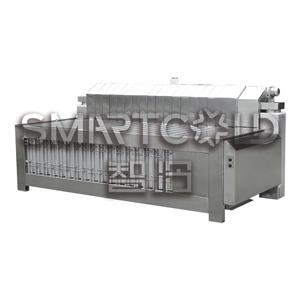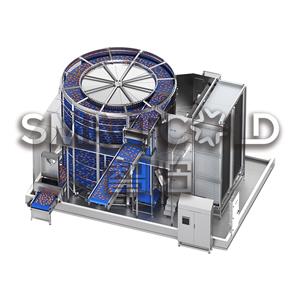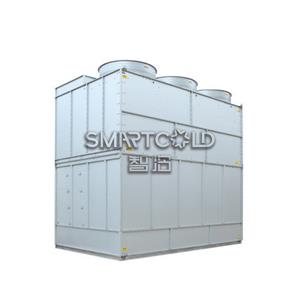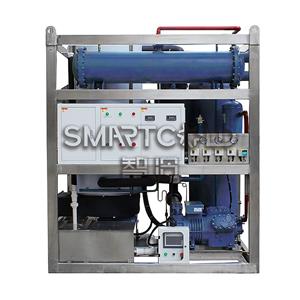Installation, debugging and maintenance methods of ammonia refrigeration system and piston refrigeration compressor
Ammonia refrigeration system installation 1. Main engine installation Distance between screw compressor couplings: model 12.5 16 20 25 32 distance mm 83-83.4 95-95.4 88-88.4 130-130.4 156-156.4 Note: ⑥The slope direction of pipelines between equipment connections shall meet the requirements in the table below: pipe name Aspect slope Compressor intake horizontal pipe Evaporator ≤ 3/1000 Compressor intake horizontal pipe (R22) compressor ≤ 10/1000 Compressor discharge horizontal pipe oil separator ≤ 10/1000 Horizontal liquid supply pipe from condenser to liquid receiver Liquid reservoir 1/1000~10/1000 Horizontal pipe from oil separator to condenser oil separator 1/1000~10/1000 ⑦The ammonia refrigeration system uses seamless steel pipes, which cannot be replaced by copper pipes or other pipes, and the inner wall must not be galvanized; the Freon system can use copper pipes or seamless steel pipes, and the inner wall must not be galvanized; cooling water and refrigerant water pipes can use galvanized welded steel pipes. 3. System blowdown, airtight test, vacuum test, ammonia filling test 1Purging and blowdown 1. Dry compressed air or nitrogen with a pressure of 0.5-0.6Mp (gauge pressure) should be used to repeatedly purge according to the system sequence, and a sewage outlet should be set at the lowest point of the equipment or pipeline to discharge sewage, and a target inspection should be set until there is no dirt. . 2Airtight test Use dry air or nitrogen, the high pressure side should be 1.8Mp, and the medium and low pressure side should be 1.2Mp. 3vacuum experiment Vacuum pumps are used, and compressors are strictly prohibited. 4Ammonia flushing experiment After the vacuum test, for the ammonia refrigeration system, a small amount of ammonia should be filled into the system by using the vacuum degree of the system; when the pressure in the system rises to 0.1-0.2MPa (gauge pressure), the ammonia filling should be stopped, and the system should be fully checked. Check for no leaks. Coloring of refrigeration equipment and piping (recommended) Equipment and pipeline name color name Equipment and pipeline name color name condenser silver gray Low pressure circulation barrel sky blue Liquid reservoir light yellow intercooler sky blue oil separator big red Drain bucket sky blue oil collector ocher yellow High and low pressure liquid pipe light yellow Ammonia separator sky blue Suction back into the trachea sky blue High pressure gas pipe, safety pipe, pressure equalizing pipe big red Body of cast iron valve black Drain pipe ocher yellow Globe valve handwheel light yellow vent pipe cream Throttle valve handwheel big red Five, the addition of working fluid Refrigerant charge: the specific gravity of ammonia is 0.65t/m 3 , and that of R22 is 1.3t/m 3 . device name Filling capacity (volume percentage) device name Filling capacity (volume percentage) condenser 15 Ammonia liquid pipe 100 Liquid reservoir 70 Return to the trachea 60 recooler 100 "Top in and bottom out" pipe (ammonia pump supply liquid) 25 intercooler 50 "Top in and bottom out" air cooler (Ammonia pump supply liquid) 40~50 Vertical low pressure circulation barrel 30~35 "Bottom in and top out" exhaust pipe (Ammonia pump supply liquid) 50~60 Horizontal low pressure circulation barrel 25 "Bottom in and top out" air cooler (liquid supplied by ammonia pump) 60~70 Vapor-liquid separator 20 Calandria (gravity-fed) 50~60 shell and tube evaporator 80 air cooler 70 plate freezer 50 Washing Oil Separator 20 Shelving pipe 50 Operation of piston refrigeration compressors
① It is strictly forbidden to use the eyebolts of the compressor or motor when lifting the unit, and only use the lifting holes reserved on the unit frame;
② The vertical and horizontal installation level deviation of the compressor is not greater than 1/1000.
Adjustment of coaxiality of motor and compressor Coaxiality
requirements:
Piston machine: ≤0.12mm
Screw machine: ≤0.04mm
① Eliminate the measurement error caused by the dial indicator at different positions.
② Only the motor can be adjusted when aligning.
③ When assembling the self-locking nut, a small amount of neutral refrigeration oil should be applied.
④The self-locking nut has a limited number of times of use and should be replaced in time.
2. Auxiliary equipment and pipeline connections
1. Pipelines
①Oxide scales inside the pipelines should be thoroughly cleaned;
②The suction and exhaust pipes of the unit should not be connected with other equipment forcibly, so as not to cause deformation of the connecting parts and offset of the motor center;
③High pressure pipes When passing through the wall, a protective cover should be added, and a gap of 10mm should be left in between. The low-pressure pipe should be lined with wood between the pipe and the bracket
; The upper branch pipe of the gas pipeline shall be connected from the upper part or the side of the main pipe.
⑤ When the suction and exhaust pipes are laid, the distance between the outer walls of the pipes should be greater than 200mm; when they are laid on the same support, the suction pipe should be installed under the exhaust pipe.
⑧ Pipe bends can be divided into two types: cold bending and hot bending. Pipes with an outer diameter of 57mm and above generally use hot bending, and pipes with an outer diameter of 57mm or less can use cold bending. When the pipe is hot-bent, the bending radius shall not be less than 3.5 times the nominal diameter of the pipe.
2. Valves
① One-way valves should be installed in the direction of refrigerant flow;
② For valves with handles, the handles should not be downwards, and the valve heads of solenoid valves, thermal expansion valves, lift check valves, etc. should be installed vertically upwards;
③The thermal expansion valve should be located close to the evaporator. The balance pipe of the externally balanced thermal expansion valve should be installed downstream of the binding place of the temperature sensing bag in the return air pipeline. The distance from the binding place of the temperature sensing bag is 150-200mm.
3. Installation and positioning
of auxiliary equipment ① The horizontal deviation of horizontal auxiliary equipment and the vertical deviation of vertical auxiliary equipment installation without special requirements should not be greater than 1/1000.
②The quadruple casing air separator should be installed horizontally, and the installation elevation is generally 1.2m. The ammonia liquid inlet end should be higher than the other end, and its slope should be 5/1000.
③Installation of equipment such as liquid receivers and horizontal evaporators with oil bags or oil drains at one end of the equipment, the slope should be 2/1000 to the side of the oil drain.
④ For low-temperature equipment installed in a normal temperature environment, hard skids should be added under the supports, and the skids should be treated with anti-corrosion in advance. The thickness of the skids should not be less than the thickness of the insulation layer.
⑤Vertical condensers are generally installed outdoors, using the condenser's circulating water pool as the basis; horizontal condensers can be installed indoors or outdoors, and when installed indoors, a distance equivalent to the length of the condenser heat exchange tube should be left for convenience. Repair and Replacement.
⑥When the ammonia refrigerator system equipment is installed, there should be a height difference of 0.3-0.4m between the condenser and the liquid storage tank.
⑦The oil collector should be installed outdoors, and the place where the oil discharge pipe should be placed should be spacious to prevent accidents caused by ammonia liquid that is difficult to deal with in time when the oil is discharged. The pressure drop pipe of the oil collector should be connected to the air return pipe of the compressor to prevent liquid return from the compressor when the pressure is reduced to recover the refrigerant.
⑧The emergency ammonia release device should be installed where it is easy to operate. During installation, the diameters of the liquid inlet, water inlet and discharge pipes of the ammonia release device should not be smaller than the pipe diameters on the equipment, and the lower part of the discharge pipe should be directly connected to the drain.
2. After the system is purged and cleaned, the valves that may accumulate dirt should be disassembled, cleaned and reassembled.
Steps:
① Check the correct installation of pressure gauges for high pressure and low pressure;
② Close all valves connected to the atmosphere; fully open other valves, force open solenoid valves, thermal expansion valves, etc
.; Valve, raise the pressure to 0.5Mp; ④Leak
detection, repair welding and fastening under pressure are not allowed ; ⑤Respectively
keep high and low pressure for 24 hours, △P is not greater than 1% of the test pressure.
△
P
- pressure drop
P
1
- pressure in the system at the beginning
P
2
- pressure in the system at the end
t
1
- temperature in the system at the beginning
t
2
- temperature in the system at the end
⑥ Venting.
When the residual pressure of the system is less than 5.33Kpa (gauge pressure is about -0.096MPa), keep the pressure for 24 hours;
When it is found that there is a leak that needs to be repaired by welding, the ammonia gas in the repair section must be released and the atmosphere can be ventilated before proceeding.
4. The insulation thickness of pipes and equipment and the
thickness of the insulation layer of the painting refrigeration device. The calculation principle is to make the calculated thickness ensure that the temperature of the outer surface of the insulation layer is not lower than the dew point temperature under local conditions, so as to ensure heat insulation. The outer surface of the layer will not condense. The heat insulation structure for ordinary cold preservation is composed of five layers from the inside to the outside: anti-rust layer, heat insulation layer, moisture-proof layer, protective layer, anti-corrosion and identification layer.




